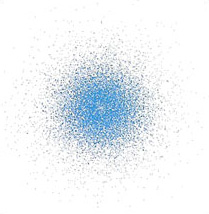2.5.1 Quantum mechanics and chance
The real quantum revolution dates from the formulation of quantum mechanics by Werner Heisenberg (1901-1976) and others in 1925, and its physical interpretation by Max Born (1882-1970) in 1926. However, before attempting even the most basic sketch of quantum mechanics let's take a small diversion into the realm of philosophy.
The basic working philosophy of most scientists, including those who say they have no philosophy, is a kind of realism. (Philosophers recognise many shades of realism.) The three main points of this creed are:
Our senses allow us to observe a physical world, and our bodies allow us to interact with that world.
Although our perceptions may differ, we all share the same physical world, which exists independently of our observations, e.g. the same Moon is really out there for all of us, even if none of us is looking at it.
Although our actions may cause disturbances, it is possible to investigate the physical world without destroying its essential structure. We may therefore try to deduce the essential features of the physical world by combining experiment and observation with rational speculation.
One of the many astonishing features of quantum mechanics is that it calls into question some of the central ideas of this kind of realist philosophy. When speaking about the nature of the microscopic entities that are described by quantum mechanics one of the subject's pioneers said:
'… they form a world of potentialities or possibilities rather than one of things or facts.'
Werner Heisenberg
Another of the quantum pioneers put it even more simply:
'There is no quantum world.'
Niels Bohr
Let's see how such statements came to be made.
By 1925 it was clear that atoms consisted of positively charged cores, called nuclei, around which swarmed negatively charged electrons. It was also clear that conventional classical mechanics was incapable of correctly describing the behaviour of those electrons, and the search was on for a new mechanics that could be applied to particles in the atomic domain. The (limited) success of Bohr's model of the atom indicated that the new mechanics would involve Planck's constant, so Max Born, a leading atomic researcher at the University of Gottingen in Germany, named the new mechanics quantum mechanics, even though he had no real idea of its basic rules at the time. It was supposed that quantum mechanics would be more fundamental than classical mechanics, so that once the rules of quantum mechanics were uncovered it would be possible to deduce the laws of classical mechanics from them.
Those basic rules of quantum mechanics were actually brought to light over a period of about a year, starting in the summer of 1925. The first breakthrough was made by Werner Heisenberg, a 24-year-old researcher at Gottingen, who had been working closely with Born. Heisenberg's first paper on the subject sketched out his basic ideas, but it was far from being a systematic formulation of quantum mechanics; neither the mathematical basis of quantum mechanics (its formalism) nor its physical meaning (its interpretation) was at all clear. Intensive work by Heisenberg, Born and others over the next six months did much to clarify the formalism (which turned out to involve mathematical objects called matrices), and to show that quantum mechanics was at least as successful as Bohr's rather unsatisfactory atomic theory, but it did not clarify the interpretation. At that stage, early in 1926, Erwin Schrödinger (1887-1961), an Austrian working at the University of Zurich, published a different and somewhat simpler formulation of quantum mechanics. Schrödinger's approach was based on de Broglie's idea that matter has a wave-like aspect. Schrödinger himself soon showed that his approach was mathematically equivalent to that of Heisenberg, but he too had difficulty working out what it all meant.
The key step in the interpretation of quantum mechanics was first put into print by Born in June 1926. Imagine that you could arrange a collision between a particle and a target and that, after the collision, the particle was deflected to the left. If you could repeat the collision under exactly the same conditions, you would naturally expect to see the particle deflected to the left again. If the particle were unexpectedly deflected to the right you would probably assume that the second collision had been set up in a slightly different way to the first, in spite of your best efforts to make the conditions identical. Born used the new formalism of quantum mechanics to study collisions and realised that, in utter contrast to classical expectations, quantum mechanics allows identical experiments to have different outcomes. Two collisions could be set up in exactly the same way (the discreteness of quantum mechanics helps to enable this). Yet, in spite of starting out in the same way, a particle may be deflected to the left in one collision and to the right in the other. In any single collision it is impossible to predict which way the particle will go.
You might wonder whether science is possible at all if Nature behaves so capriciously. Fortunately, quantum mechanics does allow us to make predictions, but with some uncertainty. In any experiment, the formalism of quantum mechanics can, in principle, predict:
the possible outcomes;
the probability (i.e. the relative likelihood or chance) of each of those possible outcomes.
However, what quantum mechanics cannot do, and what Born was convinced it would never do, was to go beyond probabilities and predict a definite outcome for a particular experiment that might have more than one outcome. Returning to the example of collisions, quantum mechanics can predict that particles colliding in a certain way might be deflected to the left or to the right: it can also predict the probability of deflection to the left or the right and hence the relative numbers deflected left or right in a large number of identical collisions: but it cannot predict whether a particular particle in a particular collision will be deflected right or left. Dealing with probabilities is an intrinsic part of quantum physics that cannot be avoided.
The use of probability in physics was not new. But the suggestion that probability was intrinsic and unavoidable was shocking. In classical physics, probability was used when something which could be known in principle (such as the exact path of a particle) was not known; probability filled the gap left by ignorance. Statistical mechanics, for example, used probabilities to estimate likely pressures and entropies, compensating for ignorance about detailed molecular motions. It was not doubted, however, that such details existed and could be determined in principle. In quantum mechanics the situation was completely different; a probabilistic statement along the lines of 'this has a 30% chance of happening' might well be the most that could be said in a certain situation, even in principle.
Niels Bohr, whose atomic theory was overthrown by quantum mechanics, was a keen supporter of the new mechanics. He had partly inspired Heisenberg to undertake its development in the first place, and in May 1926 he welcomed Heisenberg to his institute in Copenhagen where a great deal of effort went into formulating a complete interpretation of quantum mechanics that included the idea of intrinsic probabilities. The Copenhagen interpretation that emerged from this work is now regarded as the conventional interpretation of quantum mechanics, though there have always been those who have questioned its correctness. Some of the features of this interpretation are:
The measurable properties of objects (position, velocity, etc.) do not generally have values except just after a measurement.
Measurement causes potentiality to become actuality.
The measured values occur at frequencies determined by probabilistic rules. The probabilities are intrinsic and fundamental, and can be predicted by quantum mechanics.
The last of these points represents a substantial shift from classical determinism. In classical mechanics the past uniquely determines the present and hence the future. In quantum mechanics this is not so. Even the most complete possible knowledge of the past would only permit the calculation of the probability of future events. Some, perhaps a little naively, saw in this a scientific basis for free will: there was an element of freedom, or at least of chance, in the Universe.

The Copenhagen interpretation calls simple realism into question. If the most that you can say about a position measurement you are about to perform is that various values may be obtained, with various probabilities, then it may well mean that the object has no position until it is measured. Note that this is quite different from saying that the object has a position which you don't happen to know - it is as if the object had not made up its mind where to appear until the position measurement has been made. Clearly if you say that the object has no position, you call into question its independent reality, and hence the philosophy of realism, at least in its simplest form. This emphasises the enormous importance of measurement in quantum physics and the motivation for making statements such as '… they form a world of potentialities or possibilities rather than one of things or facts' and 'there is no quantum world'.
An alternative stance is to assume that there is a real world out there, but to admit that it cannot be adequately described in terms of classical concepts such as position or velocity. This is plausible. We have no right to expect microscopic physics to be just a scaled-down version of everyday experience. Given that quantum mechanics deals with a microscopic world well beyond the immediate reach of our senses and intuitions, perhaps the most surprising thing is that we can make predictions at all. From this perspective, the price that must be paid for the mismatch between our classical concepts and the quantum world is astonishingly small, and is reflected mainly in the appearance of probabilities. In philosophical terms, the concept of a real world can be preserved by admitting that certain aspects of it are inaccessible to us, clumsy giants that we are. But in practical, or scientific, terms this makes no difference. It is hard to see how we could ever develop an understanding that was not based on classical concepts, so probabilities seem destined to remain intrinsic and unavoidable, offering the only gateway through which we can glimpse the microscopic world.
Question 6
In Section 2.1 it was said that the notion of scientific law was based on the fact that identical situations produced identical outcomes. To what extent does this remain true in quantum physics where identical experiments may produce different outcomes?
Answer
In quantum mechanics, identical situations do not always produce identical outcomes. Nevertheless, a certain regularity remains because if an experimental arrangement has a variety of possible outcomes, each occurring with a definite probability, subsequent repetitions of the experiment will have the same outcomes occurring with the same probabilities. By repeating the experiment a large number of times we can check whether the probabilities predicted by quantum mechanics are valid. The most important characteristic of a scientific law is that it should be open to experimental tests. Quantum mechanics has introduced a new type of scientific law - one based on probability, which embraces the fact that identical situations do not produce identical outcomes.
